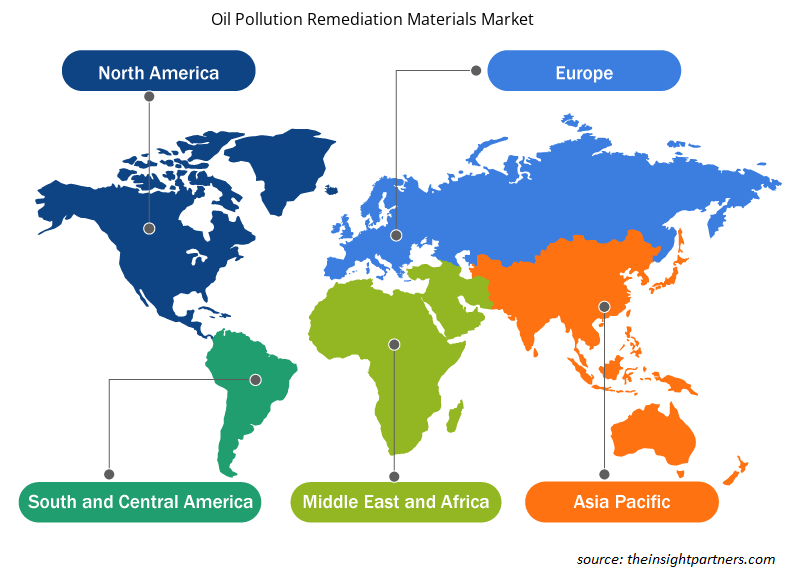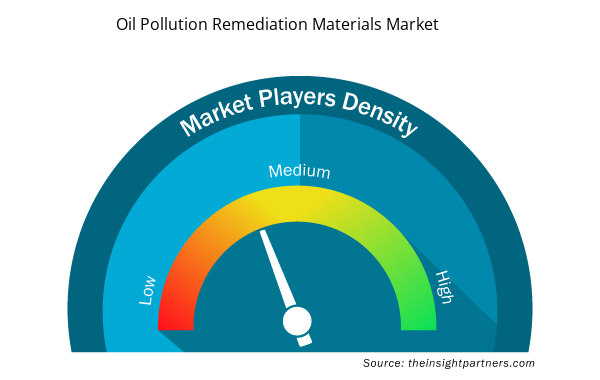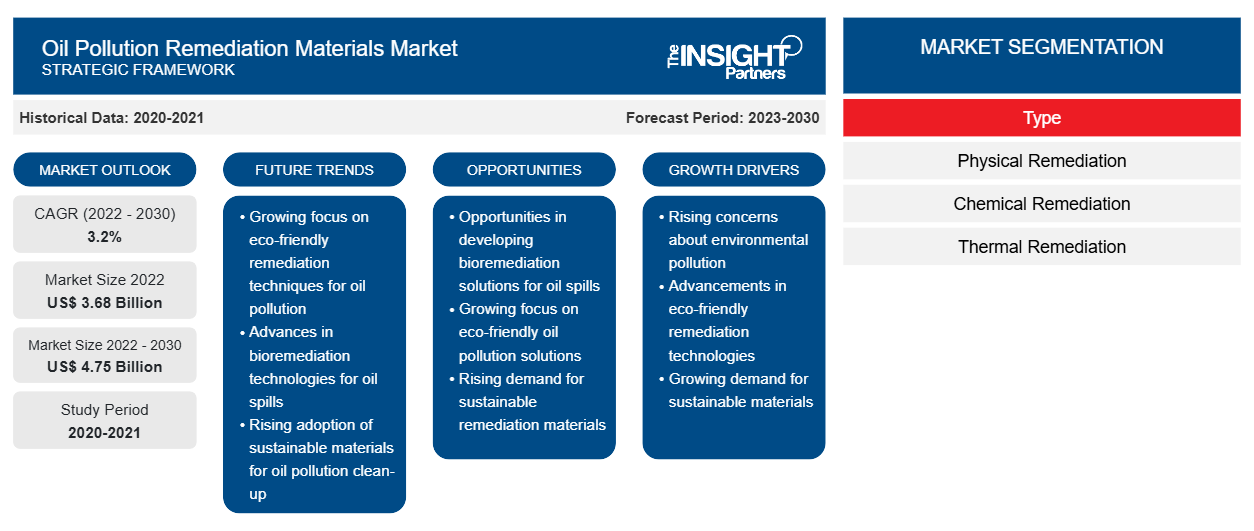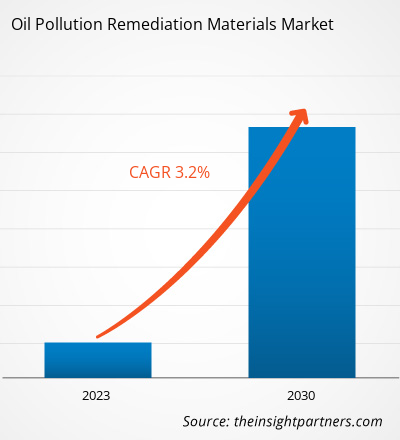[Rapporto di ricerca] L'analisi del mercato dei materiali per la bonifica dell'inquinamento da petrolio è stata valutata a 3.684,36 milioni di dollari nel 2022 e si prevede che raggiungerà i 4.749,56 milioni di dollari entro il 2030; si stima che registrerà un CAGR del 3,2% dal 2022 al 2030.
Analisi di mercato
I materiali di bonifica dell'inquinamento da petrolio vengono utilizzati per ridurre l'elevato rischio di contaminazione dei corpi idrici dovuto a varie attività di esplorazione petrolifera, trasporto e operazioni industriali che si svolgono in tutto il mondo. Le tecniche di bonifica sono principalmente classificate in bonifica fisica, bonifica chimica, bonifica termica e biobonifica. Sono considerate estremamente importanti per affrontare i problemi delle fuoriuscite di petrolio in mare. La bonifica fisica consiste in materiali quali barriere, skimmer e materiali assorbenti. I materiali di bonifica chimica includono disperdenti e solidificanti.
I principali fattori che guidano la crescita del mercato dei materiali per la bonifica dell'inquinamento da petrolio sono le crescenti attività di esplorazione e trasporto di petrolio offshore e le normative governative relative alla preparazione e alle risposte alle fuoriuscite di petrolio. Negli ultimi anni, i governi di vari paesi hanno elaborato normative per la bonifica delle fuoriuscite di petrolio per garantire una risposta rapida ed efficace alle emergenze ambientali. Tali normative in genere delineano procedure, tecnologie e standard che le aziende devono seguire per contenere, controllare e bonificare le fuoriuscite di petrolio. Le normative spesso stabiliscono il tipo di materiali di bonifica che devono essere impiegati per ridurre al minimo l'impatto ambientale e garantire una bonifica efficace. La crescente necessità di una bonifica efficace delle fuoriuscite di petrolio spinge la domanda di materiali di bonifica.
Con l'intensificarsi delle preoccupazioni e delle normative ambientali, si sta ponendo sempre più l'accento sull'uso di materiali avanzati ed ecocompatibili per la bonifica. Alcuni assorbenti, disperdenti e barriere possono essere obbligatori per soddisfare gli standard di sicurezza ed efficacia, promuovendo l'uso di materiali ecocompatibili ed efficienti negli sforzi di risposta alle fuoriuscite di petrolio. I governi e l'industria petrolifera hanno piani di preparazione per condurre una regolare risposta alle fuoriuscite di petrolio. Gli obblighi governativi di affrontare tempestivamente le fuoriuscite di petrolio e la riduzione al minimo dell'impatto ecologico hanno spinto la domanda di assorbenti, disperdenti e altri materiali di bonifica. Nel 2023, l'Agenzia per la protezione ambientale degli Stati Uniti ha rafforzato gli standard per migliorare le risposte alle fuoriuscite di petrolio nelle acque statunitensi e nelle coste adiacenti nell'ambito del National Contingency Plan (NCP) del governo federale. Gli standard includono lo sviluppo di prodotti efficaci per la bonifica delle fuoriuscite di petrolio, come agenti chimici e biologici, e la fornitura di trasparenza e informazioni relative all'uso di questi prodotti.
L'aumento delle attività di esplorazione e perforazione offshore, il trasporto di petrolio tramite oleodotti o petroliere e gli errori umani durante l'estrazione e lo stoccaggio del petrolio aumentano le possibilità di incidenti di fuoriuscita di petrolio. Secondo l'Agenzia internazionale per l'energia, la domanda globale di petrolio è rimbalzata nel 2021 e si prevede che l'Asia rappresenterà il 77% della domanda di petrolio entro il 2025. Si prevede che il fabbisogno di importazione di petrolio dell'Asia supererà i 31 milioni di barili al giorno entro il 2025. I governi di vari paesi dell'Asia Pacifica hanno avviato progetti petroliferi per soddisfare la crescente domanda di petrolio nella regione. Nel 2023, PETRONAS e i suoi Petroleum Arrangement Contractors hanno segnalato 19 scoperte di esplorazione di petrolio e gas e due successi di valutazione dell'esplorazione, contribuendo a oltre 1 miliardo di barili di petrolio equivalente di nuove risorse per la Malesia. Questo è il risultato di un programma di esplorazione intensificato perseguito negli ultimi anni, che ha visto la perforazione di 25 pozzi. Dal 2015, è il numero più alto di pozzi esplorativi perforati in un singolo anno.
Fattori di crescita e sfide
Secondo un rapporto pubblicato dalla US Energy Information Administration a gennaio 2024, la produzione di petrolio greggio è aumentata dalla pandemia di COVID-19 a partire dal 9 gennaio 2024, invertendo un calo durato due anni. La produzione di petrolio greggio degli Stati Uniti è aumentata da 11,27 milioni di barili al giorno nel 2021 a 13,21 milioni di barili al giorno nel 2023 e si prevede che raggiungerà i 13,44 milioni di barili al giorno entro il 2024. Secondo il Canada Energy Regulator, la maggior parte del petrolio greggio prodotto in Canada viene trasportato tramite oleodotti dalle province occidentali alle raffinerie negli Stati Uniti, in Ontario e nel Quebec. Secondo il rapporto pubblicato da Bruegel AISBL nel 2023, la Russia è stata tra i primi cinque maggiori produttori e consumatori di energia al mondo nel 2021. Nello stesso anno, ha prodotto 595,2 milioni di tonnellate metriche di petrolio greggio, di cui 286,6 milioni di tonnellate metriche sono state esportate. Pertanto, le crescenti attività di esplorazione e trasporto di petrolio offshore stimolano il mercato dei materiali per la bonifica dell'inquinamento da petrolio.
Personalizza questo report in base alle tue esigenze
Riceverai la personalizzazione gratuita di qualsiasi report, comprese parti di questo report, o analisi a livello nazionale, pacchetto dati Excel, oltre a usufruire di grandi offerte e sconti per start-up e università
- Scopri le principali tendenze di mercato in questo rapporto.Questo campione GRATUITO includerà analisi di dati che spaziano dalle tendenze di mercato alle stime e alle previsioni.
Approfondimenti regionali sul mercato dei materiali per la bonifica dell'inquinamento da petrolio
Le tendenze regionali e i fattori che influenzano il mercato dei materiali per la bonifica dell'inquinamento da petrolio durante il periodo di previsione sono stati ampiamente spiegati dagli analisti di Insight Partners. Questa sezione discute anche i segmenti e la geografia del mercato dei materiali per la bonifica dell'inquinamento da petrolio in Nord America, Europa, Asia Pacifico, Medio Oriente e Africa e America centrale e meridionale.

- Ottieni i dati specifici regionali per il mercato dei materiali per la bonifica dell'inquinamento da petrolio
Ambito del rapporto di mercato sui materiali per la bonifica dell'inquinamento da petrolio
| Attributo del report | Dettagli |
|---|---|
| Dimensioni del mercato nel 2022 | 3,68 miliardi di dollari USA |
| Dimensioni del mercato entro il 2030 | 4,75 miliardi di dollari USA |
| CAGR globale (2022-2030) | 3,2% |
| Dati storici | 2020-2021 |
| Periodo di previsione | 2023-2030 |
| Segmenti coperti | Per tipo
|
| Regioni e Paesi coperti | America del Nord
|
| Leader di mercato e profili aziendali chiave |
|
Densità dei player del mercato dei materiali per la bonifica dell'inquinamento da petrolio: comprendere il suo impatto sulle dinamiche aziendali
Il mercato dei materiali per la bonifica dell'inquinamento da petrolio sta crescendo rapidamente, spinto dalla crescente domanda degli utenti finali dovuta a fattori quali l'evoluzione delle preferenze dei consumatori, i progressi tecnologici e una maggiore consapevolezza dei benefici del prodotto. Con l'aumento della domanda, le aziende stanno ampliando le loro offerte, innovando per soddisfare le esigenze dei consumatori e capitalizzando sulle tendenze emergenti, il che alimenta ulteriormente la crescita del mercato.
La densità degli operatori di mercato si riferisce alla distribuzione di aziende o società che operano in un particolare mercato o settore. Indica quanti concorrenti (operatori di mercato) sono presenti in un dato spazio di mercato in relazione alle sue dimensioni o al valore di mercato totale.
Le principali aziende che operano nel mercato dei materiali per la bonifica dell'inquinamento da petrolio sono:
- Sarva Bio Remed LLC
- Tecniche dell'olio Ltd
Disclaimer : le aziende elencate sopra non sono classificate secondo un ordine particolare.

- Ottieni una panoramica dei principali attori del mercato dei materiali per la bonifica dell'inquinamento da petrolio
Panorama competitivo e aziende chiave
Sarva Bio Remed LLC, Oil Technics Ltd, Ansell Ltd, Oil-Dri Corp of America, Verde Environmental Group Ltd, Ecolab Inc, Cosco Shipping Heavy Industry Co Ltd, Regenesis, TOLSA SA e CL Solutions LLC sono tra i principali attori profilati nel rapporto di mercato sui materiali per la bonifica dell'inquinamento da petrolio. Inoltre, diversi altri attori sono stati studiati e analizzati durante lo studio per ottenere una visione olistica del mercato e del suo ecosistema. Il rapporto di mercato sui materiali per la bonifica dell'inquinamento da petrolio include anche il posizionamento e la concentrazione dell'azienda per valutare le prestazioni dei concorrenti/attori nel mercato.
Sviluppi del settore e opportunità future
Di seguito sono elencate le iniziative intraprese dai principali attori che operano nel mercato dei materiali per la bonifica dell'inquinamento da petrolio:
Nel novembre 2022, Ansell Ltd ha investito circa 80 milioni di dollari nello stabilimento produttivo greenfield in India.
- Analisi storica (2 anni), anno base, previsione (7 anni) con CAGR
- Analisi PEST e SWOT
- Valore/volume delle dimensioni del mercato - Globale, regionale, nazionale
- Industria e panorama competitivo
- Set di dati Excel



Report Coverage
Revenue forecast, Company Analysis, Industry landscape, Growth factors, and Trends

Segment Covered
This text is related
to segments covered.

Regional Scope
North America, Europe, Asia Pacific, Middle East & Africa, South & Central America

Country Scope
This text is related
to country scope.
Domande frequenti
The major players operating in the global oil pollution remediation materials market are Sarva Bio Remed LLC, Oil Technics Ltd, Ansell Ltd, Oil-Dri Corp of America, Verde Environmental Group Ltd, Ecolab Inc, Cosco Shipping Heavy Industry Co Ltd, Regenesis, TOLSA SA, CL Solutions LLC, Procon Environmental Technologies (Pty) Ltd, Brady Corp, Oil Spill Eater International Corp, Osprey Spill Control, NOV Inc, Fender & Spill Response Services LLC, RX Marine International, Cura Inc, Compania Espanola de Petroleos SA, and SkimOIL LLC.
Rising awareness of environmental issues across the world has led to an emphasis on sustainable practices. Stringent environmental regulations and compliance standards have prompted companies to adopt clean and environment-friendly practices. Companies and governments seek remediation solutions that minimize ecological impact. Thus, market players offering eco-friendly solutions for oil spill cleanup are likely to attract a large customer base and gain favor with regulatory bodies. This demand for eco-friendly solutions aligns with global efforts to mitigate the impact of pollution and support the development of green technologies.
Middle East & Africa accounted for the largest share of the global oil pollution remediation materials market. The Middle East & Africa is home to major crude oil reserves; the number of crude oil exploration activities has surged notably in this region in the past few years. Developments in technologies that aid in oil exploration and production operations have propelled the risk of oil spills, driving the demand for oil pollution remediation materials and services.
Based on type, the oil pollution remediation materials market is segmented into physical remediation (booms, skimmers, and adsorbent materials), chemical remediation (dispersants and solidifiers), thermal remediation, and bioremediation. Physical remediation is commonly used to control oil spills in a water environment. It is used to contain and recover oil that remains on the water surface without changing its properties. It is also mainly used as a barrier to control the spreading of oil spills without changing its physical and chemical characteristics.
Increased offshore exploration and drilling activities, transportation of oil via pipelines or tankers, and human errors during oil extraction and storage propel the chances of oil spill incidences. According to the International Energy Agency, the global oil demand rebounded in 2021, and Asia is expected to account for 77% of oil demand by 2025. Asia’s oil import requirements are expected to surpass 31 million barrels per day by 2025. Governments of various countries in Asia Pacific have initiated oil projects to cater to the rising demand for oil in the region.
Based on type, the bioremediation segment is expected to grow fastest during the forecast period. Bioremediation involves the use of additives to accelerate biodegradation, a natural process in which microorganisms break down complex compounds into simpler products to obtain energy and nutrients. Biostimulation and bioaugmentation are two widely used bioremediation approaches.
Trends and growth analysis reports related to Chemicals and Materials : READ MORE..
The List of Companies - Oil Pollution Remediation Materials Market
- Sarva Bio Remed LLC
- Oil Technics Ltd
- Ansell Ltd
- Oil-Dri Corp of America
- Verde Environmental Group Ltd
- Ecolab Inc
- Cosco Shipping Heavy Industry Co Ltd
- Regenesis
- TOLSA SA
- CL Solutions LLC
The Insight Partners performs research in 4 major stages: Data Collection & Secondary Research, Primary Research, Data Analysis and Data Triangulation & Final Review.
- Data Collection and Secondary Research:
As a market research and consulting firm operating from a decade, we have published and advised several client across the globe. First step for any study will start with an assessment of currently available data and insights from existing reports. Further, historical and current market information is collected from Investor Presentations, Annual Reports, SEC Filings, etc., and other information related to company’s performance and market positioning are gathered from Paid Databases (Factiva, Hoovers, and Reuters) and various other publications available in public domain.
Several associations trade associates, technical forums, institutes, societies and organization are accessed to gain technical as well as market related insights through their publications such as research papers, blogs and press releases related to the studies are referred to get cues about the market. Further, white papers, journals, magazines, and other news articles published in last 3 years are scrutinized and analyzed to understand the current market trends.
- Primary Research:
The primarily interview analysis comprise of data obtained from industry participants interview and answers to survey questions gathered by in-house primary team.
For primary research, interviews are conducted with industry experts/CEOs/Marketing Managers/VPs/Subject Matter Experts from both demand and supply side to get a 360-degree view of the market. The primary team conducts several interviews based on the complexity of the markets to understand the various market trends and dynamics which makes research more credible and precise.
A typical research interview fulfils the following functions:
- Provides first-hand information on the market size, market trends, growth trends, competitive landscape, and outlook
- Validates and strengthens in-house secondary research findings
- Develops the analysis team’s expertise and market understanding
Primary research involves email interactions and telephone interviews for each market, category, segment, and sub-segment across geographies. The participants who typically take part in such a process include, but are not limited to:
- Industry participants: VPs, business development managers, market intelligence managers and national sales managers
- Outside experts: Valuation experts, research analysts and key opinion leaders specializing in the electronics and semiconductor industry.
Below is the breakup of our primary respondents by company, designation, and region:

Once we receive the confirmation from primary research sources or primary respondents, we finalize the base year market estimation and forecast the data as per the macroeconomic and microeconomic factors assessed during data collection.
- Data Analysis:
Once data is validated through both secondary as well as primary respondents, we finalize the market estimations by hypothesis formulation and factor analysis at regional and country level.
- Macro-Economic Factor Analysis:
We analyse macroeconomic indicators such the gross domestic product (GDP), increase in the demand for goods and services across industries, technological advancement, regional economic growth, governmental policies, the influence of COVID-19, PEST analysis, and other aspects. This analysis aids in setting benchmarks for various nations/regions and approximating market splits. Additionally, the general trend of the aforementioned components aid in determining the market's development possibilities.
- Country Level Data:
Various factors that are especially aligned to the country are taken into account to determine the market size for a certain area and country, including the presence of vendors, such as headquarters and offices, the country's GDP, demand patterns, and industry growth. To comprehend the market dynamics for the nation, a number of growth variables, inhibitors, application areas, and current market trends are researched. The aforementioned elements aid in determining the country's overall market's growth potential.
- Company Profile:
The “Table of Contents” is formulated by listing and analyzing more than 25 - 30 companies operating in the market ecosystem across geographies. However, we profile only 10 companies as a standard practice in our syndicate reports. These 10 companies comprise leading, emerging, and regional players. Nonetheless, our analysis is not restricted to the 10 listed companies, we also analyze other companies present in the market to develop a holistic view and understand the prevailing trends. The “Company Profiles” section in the report covers key facts, business description, products & services, financial information, SWOT analysis, and key developments. The financial information presented is extracted from the annual reports and official documents of the publicly listed companies. Upon collecting the information for the sections of respective companies, we verify them via various primary sources and then compile the data in respective company profiles. The company level information helps us in deriving the base number as well as in forecasting the market size.
- Developing Base Number:
Aggregation of sales statistics (2020-2022) and macro-economic factor, and other secondary and primary research insights are utilized to arrive at base number and related market shares for 2022. The data gaps are identified in this step and relevant market data is analyzed, collected from paid primary interviews or databases. On finalizing the base year market size, forecasts are developed on the basis of macro-economic, industry and market growth factors and company level analysis.
- Data Triangulation and Final Review:
The market findings and base year market size calculations are validated from supply as well as demand side. Demand side validations are based on macro-economic factor analysis and benchmarks for respective regions and countries. In case of supply side validations, revenues of major companies are estimated (in case not available) based on industry benchmark, approximate number of employees, product portfolio, and primary interviews revenues are gathered. Further revenue from target product/service segment is assessed to avoid overshooting of market statistics. In case of heavy deviations between supply and demand side values, all thes steps are repeated to achieve synchronization.
We follow an iterative model, wherein we share our research findings with Subject Matter Experts (SME’s) and Key Opinion Leaders (KOLs) until consensus view of the market is not formulated – this model negates any drastic deviation in the opinions of experts. Only validated and universally acceptable research findings are quoted in our reports.
We have important check points that we use to validate our research findings – which we call – data triangulation, where we validate the information, we generate from secondary sources with primary interviews and then we re-validate with our internal data bases and Subject matter experts. This comprehensive model enables us to deliver high quality, reliable data in shortest possible time.


 Ottieni un campione gratuito per questo repot
Ottieni un campione gratuito per questo repot